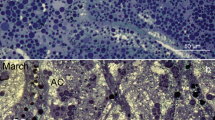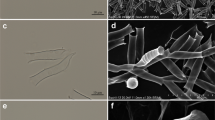Abstract
I RECENTLY reported that in the petiole of Mimosa pudica L. there are thread-like apparatuses which are stained with a basic dye solution.1 In another paper, the modes of the fixation of these thread-like apparatuses were described.2 In the present note, records of observation on the cytophysiological changes in the lacunal parenchyma of the petiole in both the diurnal and nocturnal conditions are dealt with.
This is a preview of subscription content, access via your institution
Access options
Subscribe to this journal
Receive 51 print issues and online access
$199.00 per year
only $3.90 per issue
Buy this article
- Purchase on Springer Link
- Instant access to full article PDF
Prices may be subject to local taxes which are calculated during checkout
Similar content being viewed by others
References
Toriyama, H., Cytologia, 22, 60 (1957).
Toriyama, H., Bot. Mag. (Tokyo), 71, 309 (1958).
Toriyama, H., Cytologia, 18, 283 (1953).
Toriyama, H., Cytologia, 19, 29 (1954).
Author information
Authors and Affiliations
Rights and permissions
About this article
Cite this article
TORIYAMA, H. Changes in the Lacunal Parenchyma of Mimosa pudica in Diurnal and Nocturnal Conditions. Nature 184, 737–738 (1959). https://doi.org/10.1038/184737a0
Issue Date:
DOI: https://doi.org/10.1038/184737a0
This article is cited by
Comments
By submitting a comment you agree to abide by our Terms and Community Guidelines. If you find something abusive or that does not comply with our terms or guidelines please flag it as inappropriate.



